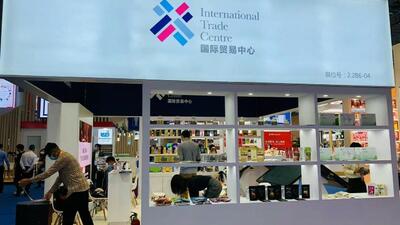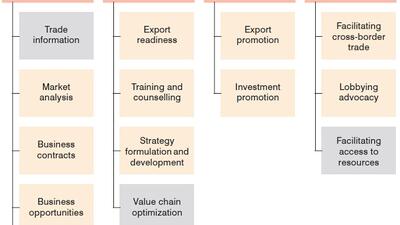
Narrowing borders, expanding trade in Latin America
Time matters for trade and its importance is likely to grow because of increasingly segmented production chains across countries and lean retailing, among other reasons.* Especially critical is the effectiveness of public entities that affect the transit times between origins and destinations of goods.
This is particularly the case with customs but also with a number of regulatory agencies, such as those responsible for health, food and quarantine. The manner in which their trade-related regulations are designed and enforced determines the thickness of the borders and the time required to cross them. Trade facilitation measures precisely aim to streamline the administrative processing of trade flows, thereby narrowing the border and speeding the movement of goods.
Latin American countries have recently implemented various initiatives in this direction, in several cases with technical and financial support from the Inter-American Development Bank (IDB).
RISK MANAGEMENT MAKES A VITAL DIFFERENCEAmong these trade facilitation initiatives is the introduction of risk-based inspection procedures which allow for focusing controls on high risk shipments instead of inspecting every single shipment.
Results from a recent study conducted by IDB suggest that if all exports would have been physically inspected and such inspections would have taken two days, total Uruguayan exports in 2011 would have been approximately 15% lower.** This highlights why utilization of riskbased verification procedures and expedited controls should be key components of trade facilitation strategies. Still, the ultimate goal should be the adoption of an integral risk management system encompassing all relevant border agencies.*** Despite the significant progress made by Latin American countries in this area, that goal remains elusive.
TRANSIT REGIMES AND THE AEO PROGRAMMETrade can face more acute problems when goods have to be shipped through third countries because multiple border crossing and agencies from different countries are involved. This is particularly important for road-based regional trade and specifically within regional trade agreements.
Well-functioning transit regimes are virtually absent in most developing regions One of the few exceptions can be found in Latin America: the Central American TIM (Tránsito International de Mercancías, or International Transit of Goods). It implied the gradual adoption of a common electronic document and the interconnection of participating border agencies to make possible a unified transit border control. This in turn allowed for real-time control of flows and significant reductions in the time required to trade across borders and thus in trade costs. Evidence from an IDB study on El Salvador and Guatemala revealed that the TIM favoured an increase in their firms’ exports, primarily through higher shipment frequency****.
The Authorized Economic Operators (AEO) programme is another important trade facilitation initiative in which cooperation will be essential to maximize its impact on trade. AEOs are firms – certified by customs administrations as complying with relevant supply chain security standards – entitled to trade facilitation benefits, primarily consisting of less frequent physical inspections and reduced clearance times. AEO programmes have been adopted in 11 Latin American countries and two of these countries have already signed mutual recognition agreements (MRAs) with partners.*****
Trade facilitation in Latin AmericaProgress towards trade facilitation in Latin America has been noticeable in recent years. However, much remains to be done. The implementation of the World Trade Organization’s Trade Facilitation Agreement provides countries in the region with a unique opportunity to move this policy agenda forward.
As such, in addition to endowing border agencies with proper personnel and technological means to accomplish their mission, countries must ensure better coordination between agencies; better design or re-design their procedures; and put in place effective and interoperable mechanisms to process permits and certificates, which would create the conditions for comprehensive single windows as well as for integrated border controls. They would also have to improve their risk management systems, including the adoption of an integral risk approach linking all border agencies; upgrade their transit regimes; and strengthen and connect their AEO programmes with those of peers through MRAs.
The IDB has been and is currently supporting the efforts of Latin American countries to implement the aforementioned trade policy agenda through loans, technical assistance, capacity building schemes, and a series of studies that aim to assess and inform the impact of the different component of this agenda.
Supported initiatives and countries include single windows (Chile, Costa Rica, Colombia, Panama, Peru, Uruguay), interoperability of single windows (Pacific Alliance and associated countries), border crossings and coordinated border management (Ecuador and Colombia, Nicaragua and Costa Rica), AEO programmes (most countries), and training on trade and customs issues, single window, transit trade, and AEOs.
Trade gains from these measures are likely to be substantial and so would those additional rewards from additional employment opportunities and increased productivity.
* See, e.g., Hummels et al. (2001), Hummels (2007),
Hummels and Schaur (2013), Evans and Harrigan (2005);
and Harrigan and Venables (2006).
** In addition to their actual coverage, the speed of the
controls also matters: if all shipments that were subject to
physical inspection and spent more than two days in customs
would have been released within one day as those
processed without those inspections, exports would have
been 5.9% larger (see Volpe Martincus et al., 2015a).
*** Marquez Fariña and Volpe Martincus (2014).
**** Carballo et al (2015).
**** See Corcuera-Santamaría and García Navarrete
(2014).








